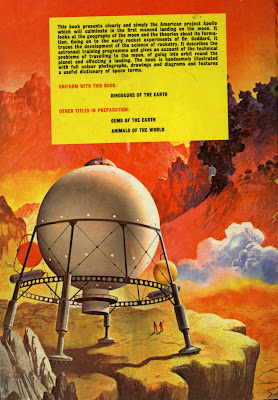
Happy Halloween!!! Here is your treat for today (Be sure to click on the image): your own "Space Diorama."
Not quite a punch-out but rather a cut-out set of space pictures. One of the magazines for kids that was popular when I was little was Jack & Jill. It was always moderately interesting and it is always fun to get stuff in the mail. This was a centerfold that you could cut out. Usually they would have a game but it was a "Space Diorama" this time.

As you can see it was not presented as science fiction but rather something that just hasn't happened yet.

The influence of Chesley Bonestell's (and other) space art is undeniable in this illustration. This is what it would look like to stand on the Moon.
 I also like the Rolf Klep style space suits. The three illustrators of the Collier's magazine space series were Rolf Klep, Fred Freeman, and Chesley Bonestell. Both Freeman and Bonestell were known for their magazine illustration but Klep was much less known. Nevertheless his spacesuit illustration set a standard for how suits should look.
I also like the Rolf Klep style space suits. The three illustrators of the Collier's magazine space series were Rolf Klep, Fred Freeman, and Chesley Bonestell. Both Freeman and Bonestell were known for their magazine illustration but Klep was much less known. Nevertheless his spacesuit illustration set a standard for how suits should look. As compared to the work of this unknown Diorama artist:
As compared to the work of this unknown Diorama artist:

The spaceship's basic form was established in the early 1950s so this Diorama perpetuates the "classic" form.
 Thanks for looking at this odd bit of ephemera. It still amazes me that almost exactly 10 years after this illustration was published of the "long time in the future" there were men on the Moon.
Thanks for looking at this odd bit of ephemera. It still amazes me that almost exactly 10 years after this illustration was published of the "long time in the future" there were men on the Moon.

 Why with Mickey Mouse of course. It looks like the art was done for this coloring book before the final construction of the Rocket to the Moon ride.
Why with Mickey Mouse of course. It looks like the art was done for this coloring book before the final construction of the Rocket to the Moon ride.












 Are they orbiting Mars?
Are they orbiting Mars? Of course you need your Moon Buggy!
Of course you need your Moon Buggy! This next one looks like a contractor's illustration except I think they are orbiting Mars.
This next one looks like a contractor's illustration except I think they are orbiting Mars. And this one takes us back to the Moon. Wait a minute, wasn't this book supposed to be about the Apollo mission to the Moon?
And this one takes us back to the Moon. Wait a minute, wasn't this book supposed to be about the Apollo mission to the Moon?





 And of course, where would we be without our base on the Moon. Except of course that IS Saturn in the sky next to Earth. Maybe we will move the planets around in the future to create more inspiring sky scenes. Or maybe Saturn is so cool to look at that artists can't resist sticking it in any picture.
And of course, where would we be without our base on the Moon. Except of course that IS Saturn in the sky next to Earth. Maybe we will move the planets around in the future to create more inspiring sky scenes. Or maybe Saturn is so cool to look at that artists can't resist sticking it in any picture. The last illustration to share seems to be of the "moon children." It seem like there is another helpful race of folks around to help with our space future. More likely it will be the relaxing of child labor laws that will allow children out into space. My new cry for future children is not: "You will go to the Moon!" but rather "You must go to the Moon!" (To build our bases please).
The last illustration to share seems to be of the "moon children." It seem like there is another helpful race of folks around to help with our space future. More likely it will be the relaxing of child labor laws that will allow children out into space. My new cry for future children is not: "You will go to the Moon!" but rather "You must go to the Moon!" (To build our bases please).








 Everyone remembers Jet-Packs and wants their own but what happened to my Flying Platform!
Everyone remembers Jet-Packs and wants their own but what happened to my Flying Platform! Here is a very early model of the proposed Lunar Lander
Here is a very early model of the proposed Lunar Lander

